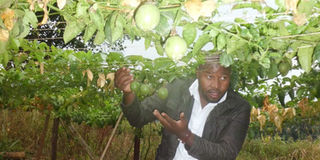How to get a great passion yield

Julius Ahangaana, explains the different practices farmers should adopt at the demonstration farm in MAURIK Kabanyoro. PHOTO by Lominda Afedraru
What you need to know:
- Passion fruit is a perennial vine crop which grows to give oval or round shaped fruit. It is native to tropical regions of southern Brazil and it is also grown in Uganda mainly in Masaka and Kasese districts, writes Lominda Afedraru
Passion fruit is easy to grow and a farmer is able to reap within eight-12 months. The most common types grown by farmers include the purple Grandilla popularly known for its scent locally known as Kasese, Masaka and Kenyan passion fruit variety.
Another type is the highly resistant hybrid which is a cross between the local purple and the yellow passion fruit which farmers in Northern Uganda grow for its aromatic but rather acidic blend.
Julius Peter Ahangaana agronomist from Makerere University Agricultural Research Institute Kabanyolo (MUARIK), explaining best practices farmers should adopt when growing passion fruits, notes that propagation is done using seeds, cloning and grafted prop gules.
A farmer who observes best practice is capable of harvesting 11,000 kg of passion fruits in a season because one plant is capable of producing 20 kg of the fruit. According to Ahangaana, farmers are expected to sell one kg of passion fruit at Shs2, 000 meaning a farmer is capable of reaping Shs22m in one season and Shs44m per annum.
Seed extraction
For seed extraction, Ahangaana says, healthy mature fruits are collected from the parent plant and seeds are scooped from the ripe fruits. Extracted seeds are put in water for about three days to ease the separation of seed and pulp. The seeds are then dried under shade and later stored in a cool dry and dark place to avoid loss of viability.
Seeds are either planted in prepared seed bed or into 6cm wide bags filled with sterilised soil. “Sterilization can be easily achieved by using steam and this is mainly aimed at killing parasitic nematodes and soil-borne disease pathogens,” he says.
Preparing your land
Land preparation is done by slashing the farm and farmers are advised to use herbicides to eliminate weeds. Thereafter, a hole of 30cm by 30cm is dug and the soil which is removed from the hole should be mixed with manure and poured back in the hole. Spacing should be 3cm by 3cm apart and one acre of land accommodates between 550 to 600 plants.
When planting, a small hole is opened and one has to apply five grammes of Diammonium phosphate (DAP) fertilizer in the small hole and cover it slightly then plant the seedling.
Transplant the seedlings at the onset of the rainy season and it should be in the morning or late evening to reduce chances of their failure due to heat stress. Farmers are advised to plant passion fruits on land which receives sufficient sunlight.
Fertilise your garden
After one month, the farmer should begin applying nitrogen, phosphorus and potassium (NPK) fertiliser in a ring dug round the plant. This should be done after every two months up to the flowering stage. When the plants begin flowering, farmers are expected to apply fertiliser containing only potassium which helps in flower formation.
Farm practices
There are two common farm practices adopted by farmers, namely the elaborate trellising system where the wires and plastic ropes run across the poles and the sideway trellising system where the ropes run horizontally and the plants are spread sideways.
According to Ahangaana, sideway trellising is recommended because it allows the plants to spread well, giving room to enough sunlight whereas the elaborate trellising system leads to too much accumulation of shed which is not good for the plants growth.
A seasoned journalist, John Baptist Wasswa, who has since retired into passion fruit farming in his Bongole farm, Buwama, says it is important to spray the plant with chemicals to avoid pest infestation.
The challenge is that passion fruits require a lot of time dedicated to supervision, through the various stages right from the nursery to harvest.
PESTS AND DISEASES
John Bosco Muhumuza, a research officer and crop entomologist at Mbarara Zonal Agricultural Research and Development Insititute reveals the following as common diseases and pests that may affect ones passionfuits; Passion fruit virus disease(Woodiness virus, mottle virus and crinkle virus), Brown spot, Alternaria spot, Anthracnos, Grease spot, Collar/black leg. Effective management of these diseases involves prevention of infection, minimising the sources of infection and breaking the disease cycle.
Management of passion fruit virus diseases involves use of disease free planting materials. Here, plants found to be infected are destroyed to avoid further spread of the virus by vegetative propagation or by aphid infections, disinfecting tools when pruning, and avoid using plant material from infected vines for grafting.
Mr Muhumuza explains that management of diseases can be achieved by essential control strategies including canopy management, orchard hygiene, and effective fungicide spray programme.
The pests include Aphids which suck the juice from the fruit, thrips which sucks sap from the flowers causing them to fall off, mealbugs which attacks the fruit stock leading to formation of molds. The infected fruit becomes distorted with hard cover and woody vines and the leaves are yellow making the plant stunted.
Ahangaana tips that one should apply cooper based fungicide and insecticide on timely basis to control the diseases and soil used to germinate seedlings should be sterilized to eliminate oil borne diseases. By Zadock Amanyisa




